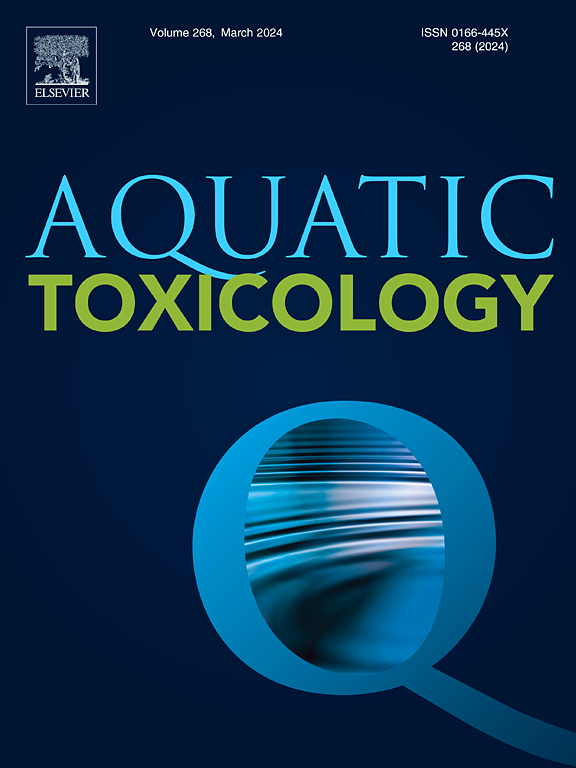印度 Teesta 河淡水鱼 Pethia conchonius 在唑啉草酯诱导下的遗传毒性。
IF 4.1
2区 环境科学与生态学
Q1 MARINE & FRESHWATER BIOLOGY
引用次数: 0
摘要
唑啉草酯是一种广泛使用的杀真菌剂,可通过地表径流污染水体,对水生生物构成风险。本研究旨在评估唑啉草酯对海螺鱼的基因毒性影响。经测定,唑啉草酯的 96 小时致死浓度(LC50)为 0.514 毫克/升。根据半数致死浓度,采用 0.025 毫克/升、0.0514 毫克/升和 0.103 毫克/升三个亚致死浓度(SLCs)对鱼类进行 96 小时暴露。微核试验(MN)和彗星试验分别用于评估核异常和 DNA 损伤。结果显示,随着浓度和接触时间的增加,接触组的核异常和 DNA 损伤频率明显高于对照组。这些结果表明,唑虫酰胺对鱼类具有很强的遗传毒性,会造成严重的 DNA 损伤。本文章由计算机程序翻译,如有差异,请以英文原文为准。
Azoxystrobin induced genotoxicity in Pethia conchonius, a freshwater fish of river Teesta, India
Azoxystrobin, a widely used fungicide, can contaminate water bodies through surface run-off, posing a risk to aquatic organisms. This study aimed to assess the genotoxic effects of azoxystrobin on the fish Pethia conchonius. The 96 h lethal concentration (LC50) of azoxystrobin was determined to be 0.514 mg/L. Based on LC50, three sub-lethal concentrations (SLCs) of 0.025 mg/L, 0.0514 mg/L, and 0.103 mg/L were used to expose fish for 96 h. The blood and gill samples were collected at 24 h intervals for analysis. The Micronucleus (MN) and Comet assays were used to evaluate nuclear abnormalities and DNA damage, respectively. The results showed that the frequency of nuclear abnormalities and DNA damage in the exposed groups was significantly higher than the control, with increasing concentrations and duration of exposure. The highest levels of micronuclei, notched and blebbed nuclei, and DNA damage parameters were observed in the group exposed to SLC III for 96 h. These findings indicate that azoxystrobin is highly genotoxic to fish causing severe DNA damage.
求助全文
通过发布文献求助,成功后即可免费获取论文全文。
去求助
来源期刊

Aquatic Toxicology
环境科学-毒理学
CiteScore
7.10
自引率
4.40%
发文量
250
审稿时长
56 days
期刊介绍:
Aquatic Toxicology publishes significant contributions that increase the understanding of the impact of harmful substances (including natural and synthetic chemicals) on aquatic organisms and ecosystems.
Aquatic Toxicology considers both laboratory and field studies with a focus on marine/ freshwater environments. We strive to attract high quality original scientific papers, critical reviews and expert opinion papers in the following areas: Effects of harmful substances on molecular, cellular, sub-organismal, organismal, population, community, and ecosystem level; Toxic Mechanisms; Genetic disturbances, transgenerational effects, behavioral and adaptive responses; Impacts of harmful substances on structure, function of and services provided by aquatic ecosystems; Mixture toxicity assessment; Statistical approaches to predict exposure to and hazards of contaminants
The journal also considers manuscripts in other areas, such as the development of innovative concepts, approaches, and methodologies, which promote the wider application of toxicological datasets to the protection of aquatic environments and inform ecological risk assessments and decision making by relevant authorities.
 求助内容:
求助内容: 应助结果提醒方式:
应助结果提醒方式:


